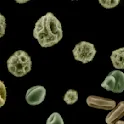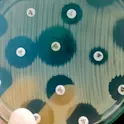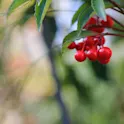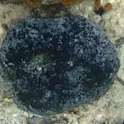
Featured news
30 Sep 2025
Natural antimicrobial drugs found in pollen could help us protect bee colonies from infection
Pollen gathered by honeybees contains antimicrobial-producing bacteria that protect the hive against disease

Featured news
30 Sep 2025
Pollen gathered by honeybees contains antimicrobial-producing bacteria that protect the hive against disease

Featured news
10 Jul 2025
Scientists monitoring wastewater find a range of antibiotic-resistant bacteria — but natural compounds show promise for fighting them off.

Featured news
21 May 2025
Researchers used high-throughput DNA sequencing to measure biodiversity along a transect – a succession from recently exposed to mature soil – in front of a glacier in Antarctica. To capture a detailed ecological ‘time sequence’ they distinguished between intracellular and extracellular DNA from living versus dead or locally extinct species. They found an abundance of previously unsuspected interactions between eukaryotes and prokaryotes, eg, algae with heterotrophic bacteria and fungi with actinobacteria. The results imply that novel mutualistic interactions play an essential role in shaping this system, and that biodiversity in Antarctica may be much greater than previously thought.

Featured news
14 Feb 2025
Researchers from Spain sampled sink drains from different wards in a single modern university hospital where state-of-the-art cleaning protocols are adhered to. Through culturing and DNA barcoding, they found 67 species of bacteria. These included Klebsiella, Enterobacter, and Pseudomonas aeruginosa, notorious for their potential to cause healthcare-associated infections. Several strains detected proved resistant to modern antibiotics, including cephalosporins and carbapenems. Sink drains thus appear to function as reservoirs for known and emerging pathogens of concern.

Featured news
17 Dec 2024
Scientists investigated the noses of people with asthma and allergic rhinitis and found that the fungi in their noses are different to healthy people, suggesting future targets for treatments.

Health
30 Aug 2024
Researchers from Finland and Norway developed a new suite of methods for the screening of antivirulence activity of unknown compounds of bacterial origin. The compounds tested had been derived from actinobacteria living inside invertebrates in the Arctic Sea. They found two interesting compounds with strong antivirulence or antibacterial effects against enteropathogenic E. coli. These results demonstrate the potential of prospecting novel habitats for promising new antibacterial drugs, to solve the current global antibiotics crisis.

Featured news
08 Aug 2024
Researchers have measured the diversity of microbes inside microwaves for the first time. They showed that microwaves harbor a specialized community of locally adapted microbial genera, which resembles that reported on kitchen surfaces and in another extreme, highly irradiated habitat: on solar panels. This finding has potential biotechnological applications, in processes that require microbes resistant to thermal shock, radiation, and desiccation.

Featured news
08 Feb 2024
In a new Frontiers’ guest editorial, Prof Dr Lembit Sihver and his co-authors explore the impact the microbiome has on human health in space. They also discuss potential applications as well as challenges of the study of the microbiome of astronauts.

Featured news
05 Dec 2023
At Frontiers, we bring some of the world’s best research to a global audience. But with tens of thousands of articles published each year, it’s impossible to cover all of them. Here are just five amazing papers you may have missed.

Life sciences
01 Dec 2023
Researchers from Spain and Turkey have shown that Vibrio bacteria are playing a role in the outbreaks of mortality of a sessile marine organism, the dark stinging sponge (Sarcotragus foetidus).

Featured news
08 Nov 2023
by Angharad Brewer Gillham, Frontiers science writer Image/Shutterstock.com Scientists have found that specially processed samples of willow bark extract have an antiviral effect which isn’t seen in already known medical compounds from willow bark, such as salicylic acid, the precursor to modern aspirin. The extract worked against two common types of virus with very different structures, enteroviruses and coronaviruses, suggesting the potential for a new broad-spectrum antiviral to help us fight viruses that are otherwise hard to treat. From a seasonal cold to a stomach bug, nobody likes catching a virus — and epidemics can be devastating. We need safe, sustainable antiviral options to treat the outbreaks of the future. Scientists in Finland have now shown that an extract of willow bark — a plant which has already provided several medicines, including the precursor to modern aspirin — has a broad-spectrum antiviral effect in cell sample experiments. The extract worked both on enveloped coronaviruses, which cause colds as well as Covid-19, and non-enveloped enteroviruses, which cause infections such as flu and meningitis. There are no clinically approved drugs which work against enteroviruses directly, so this extract could be a future game-changer. “We need broadly acting and efficient tools to combat […]

Environment
14 Sep 2023
By Deborah Pirchner, Frontiers science writer Image: Shutterstock.com At Frontiers, we bring some of the world’s best research to a global audience. But with tens of thousands of articles published each year, it’s impossible to cover all of them. Here are just five amazing papers you may have missed. Polar bear identity and sex can be established from paw prints The recent loss of sea ice is forcing polar bears – one of the Arctic’s biggest predators – to spend more time on land closer to human settlements. To prevent potential human-animal conflicts and to protect the species, polar bear populations must be monitored and managed. More often than not, this is a costly and difficult endeavor, in part because of the remote regions the bears inhabit. Now, a team of researchers in the US has developed a method to keep track of polar bears that might make scientist less reliant on having to capture the bears to get data. Writing in Frontiers in Conservation Science, they investigated the use of environmental DNA – cells which the animals shed when walking – collected from paw-prints in the snow to identify individual polar bears and their sex. They sampled 13 polar […]

Featured news
13 Sep 2023
By Mischa Dijkstra, Frontiers science writer Researchers have shown that high concentrations of key proteins in human breast milk, especially osteopontin and κ-casein, are associated with a greater abundance of two species of bacteria in the gut of babies: Clostridium butyricum and Parabacteroides distasonis, known to be beneficial for human health and used as probiotics. These results suggest that proteins in breast milk influence the abundance of beneficial gut microbes in infants, playing an important role in early immune and metabolic development More than 320 million years of mammalian evolution has adapted breast milk to meet all the physiological needs of babies: it contains not only nutrients, but also hormones, antimicrobials, digestive enzymes, and growth factors. Furthermore, many of the proteins in breast milk, for example casein and milk fat globule membrane proteins, aren’t just sources of energy and molecular building blocks, but also directly stimulate immunity, at least under preclinical conditions. Likewise, the gut microbiome, composed of bacteria, archaea, and fungi, plays a vital role in the regulation of the immune system. This raises the possibility that the immune-boosting function of breast milk proteins might be two-pronged: not only by stimulating the immune system directly, but also indirectly, by […]

Featured news
15 Aug 2023
by Angharad Brewer Gillham, Frontiers science writer Image/Shutterstock.com Scientists studied the microbes present at different stages of the mozzarella-making process at different dairies using DNA analysis. Most of the bacteria were either Lactobacillus or Streptococcus, but at a smaller dairy, more minor bacterial families were found. The general similarity of the microbiota involved between dairies suggests that, despite minor differences between manufacturers, the same microbes make the mozzarella. Mozzarella is far more than just a pizza topping. A unique Italian cheese, buffalo mozzarella from Campania has been recognized as a delicacy and protected under EU law for nearly 30 years. But what makes this mozzarella so special? The ingredients are simple: water buffalo milk, rennet, and natural whey starter, processed using fresh water and brine. But the natural whey starter contains microbes that are crucial to developing the mozzarella. Scientists from Italy used high-throughput 16S rRNA amplicon sequencing, which gives a detailed picture of what microbes are present and in what proportions, to understand how microbes make mozzarella. “This study sheds light on the intricate interactions of microorganisms throughout the manufacturing process and fosters a deeper understanding of the craftsmanship behind this esteemed Italian cheese,” said Dr Alessia Levante of […]

Featured news
02 Aug 2023
By Deborah Pirchner, Frontiers science writer Image: Shutterstock.com At Frontiers, we bring some of the world’s best research to a global audience. But with tens of thousands of articles published each year, it’s impossible to cover all of them. Here are just five amazing papers you may have missed. Certain foods help ease chronic pain Chronic pain caused by rheumatic diseases often requires prolonged treatment using drugs which are associated with side effects. Eating a certain diet, however, has been suggested as a possible way to alleviate chronic pain symptoms. Recommended foods include berries, fatty fish, and avocados. In a pilot study, researchers in Spain have evaluated the efficacy of an anti-inflammatory diet in patients with chronic pain. They have published their findings in Frontiers in Nutrition. In a first step, the researchers designed a 13-item anti-inflammatory dietary guide, including anti-inflammatory foods like curcumin and coffee. Foods with inflammatory properties, for example red meat, gluten, and cow’s milk, were excluded from the list. In the second part of the study, participants followed the diet for four months. The researchers found a positive correlation between the anti-inflammatory food participants ate and physical characteristics, stress, and pain. Consuming the anti-inflammatory diet also […]
Get the latest research updates, subscribe to our newsletter